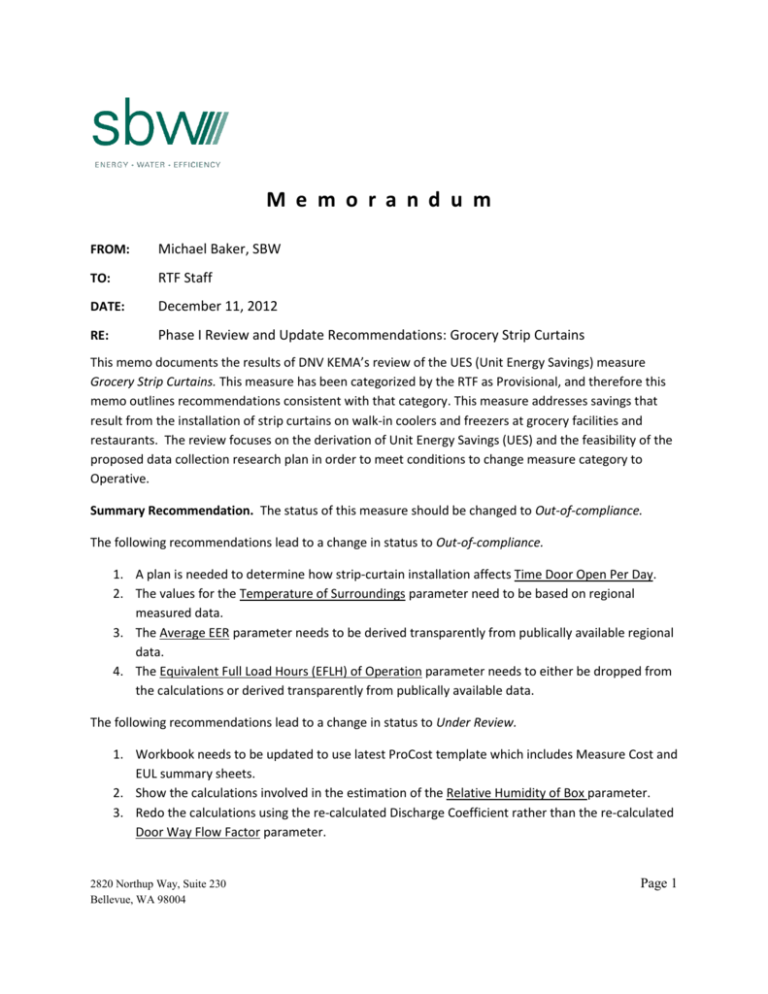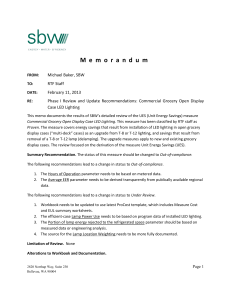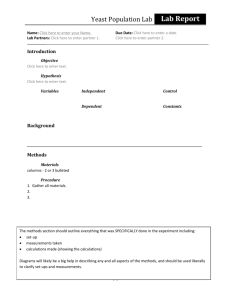The status of this measure should be changed to Out-of
advertisement

M e m o r a n d u m FROM: Michael Baker, SBW TO: RTF Staff DATE: December 11, 2012 RE: Phase I Review and Update Recommendations: Grocery Strip Curtains This memo documents the results of DNV KEMA’s review of the UES (Unit Energy Savings) measure Grocery Strip Curtains. This measure has been categorized by the RTF as Provisional, and therefore this memo outlines recommendations consistent with that category. This measure addresses savings that result from the installation of strip curtains on walk-in coolers and freezers at grocery facilities and restaurants. The review focuses on the derivation of Unit Energy Savings (UES) and the feasibility of the proposed data collection research plan in order to meet conditions to change measure category to Operative. Summary Recommendation. The status of this measure should be changed to Out-of-compliance. The following recommendations lead to a change in status to Out-of-compliance. 1. A plan is needed to determine how strip-curtain installation affects Time Door Open Per Day. 2. The values for the Temperature of Surroundings parameter need to be based on regional measured data. 3. The Average EER parameter needs to be derived transparently from publically available regional data. 4. The Equivalent Full Load Hours (EFLH) of Operation parameter needs to either be dropped from the calculations or derived transparently from publically available data. The following recommendations lead to a change in status to Under Review. 1. Workbook needs to be updated to use latest ProCost template which includes Measure Cost and EUL summary sheets. 2. Show the calculations involved in the estimation of the Relative Humidity of Box parameter. 3. Redo the calculations using the re-calculated Discharge Coefficient rather than the re-calculated Door Way Flow Factor parameter. 2820 Northup Way, Suite 230 Bellevue, WA 98004 Page 1 4. The measure definition should clarify whether or not the measure applies to walk-in units with loading dock exterior doors. Limitation of Review. None Alterations to Workbook and Documentation. A worksheet called “Summary” has been added to the workbook. This sheet describes how measures are identified, lists important constants and their sources, describes the savings estimation algorithm and the associated baseline and efficient case parameters and their sources for each measure and UES component. Data relevant to California Climate Zones 1 – 16 have been removed from the following worksheets. This information has no bearing on savings calculations specific to the Pacific Northwest. Data removed included low temperature (LT) and medium temperature (MT) average EER, EFLH, peak EER, compressor power, and kWh savings values. o “Restaurant Assumptions”, “C-store Assumptions”, “GRO Assumptions”, and “WRF Assumptions” worksheets – Removed Rows 30 – 46 o “Restaurant Energy Savings”, “C-Store Energy Savings”, “GRO Energy Savings”, and “WRF Energy Savings” worksheets – Removed Rows 6 – 22, 28 – 44, 49 – 65, 71 – 87, and 92 – 108 Recommendations for Updates. The RTF should implement the following recommendations: 1) Workbook Structure and Formulas a) Workbook needs to be updated to use latest ProCost template, which includes Measure Cost and EUL summary worksheets. This deficiency causes a change of status to Under Review. 2) Documentation a) No changes recommended 3) Measure Definition a) The measure definition should clarify whether or not the measure applies to walk-in units with loading dock exterior doors. The average environmental temperatures used in the ADM HIM report (see Input Parameters below) apparently include some fraction of exterior spaces, but this needs to be verified by examination of the temperature data and the calculations leading to the average temperatures. This deficiency causes a change of status to Under Review. 4) UES Savings Estimation Method a) No changes recommended 5) Input Parameters Page 2 a) In February, 2011, PECI submitted a research plan to measure Time Door Open Per Day for both Baseline and Efficient Case conditions. UES calculations currently use inputs from the referenced ADM report but this report does not indicate how this value may change after strip curtain installation. The PECI Research Plan called for the collection of Time Door Open per Day for both pre- and post-installation periods to ensure the savings calculations account for any post installation variation in door open times. PECI presented results from metering in August 2011, which showed that the results were not statistically significant. PECI requested a one year extension in provisional status at that time. This period has expired. Without revising the sunset date or proposing a revised plan to determine this parameter, this deficiency causes a change of status to Out-of-compliance. b) The values for the Temperature of Surroundings parameter, which are found on the “Assumptions” worksheets for the various building types, need to be based on regional measured data. The current values reportedly are based on Appendix E in the ADM report, but do not match the referenced table values which appear to be Tables E-1 and E-2 of the Report Appendix1. Appendix E includes the following description of the derivation of the average temperatures: Figure E‐5 shows the average temperature differential between the infiltrating and refrigerated airs, weighted by the amount of time that the walk‐in doors are open per hour. The infiltrating air temperature for each hour of the year is determined by a regression that predicts the infiltrating air temperature based on the outdoor temperature and some parameters that describe the thermal properties of the space that surrounds the walk‐in cooler or freezer (e.g. conditioned space, loading bay, outdoors). A similar process needs to be repeated for the region. We have not been able to secure the calculations used in the ADM report. This deficiency causes a change of status to Out-ofcompliance. c) The Average EER parameter is based on proprietary DOE 2.2-R simulations of Northwest grocery environments. This parameter needs to be derived transparently from publically available data. This deficiency causes a change of status to Out-of-Compliance. d) The Equivalent Full Load Hours (EFLH) of Operation parameter does not appear to be appropriate for these calculations. This purpose of this parameter needs to be clarified. If the need exists for EFLH in the calculations, the value needs to be derived transparently from publically available regional data. This deficiency causes a change of status to Out-ofCompliance. e) The parameter, Relative Humidity of Box, is noted with the comment, “Calibrated to match final calculation results to ADM HIM report results before adjusting any other inputs.” The calculations involved in this calibration should be shown. This deficiency causes a change of status to Under Review. 1 ADM Associates, Inc, (2010), Commercial Facilities Contract Group, 2006-2008 Direct Impact Evaluation, Study ID: PUC0016.03 – Volume 3 of 3 HIM appendices Page 3 f) The parameter, Door Way Flow Factor, is noted with the comment, “Calibrated to match final calculation results to ADM HIM report results before adjusting any other inputs.” The way this parameter is calculated in the workbook leads to Door Way Flow Factor values much lower than those used in the report. The savings calculation would more closely match the report, and thereby be more transparent, if the workbook calculations explicitly showed the intermediate value, Q, the infiltration in CFM, calculated using Equation D-4 in Appendix D rather than implicitly calculating Q using Equation D-3. Though the results are the same, using Equation D-4 would allow the use of the discharge coefficient calculated in the HIM report rather than an adjustment in the doorway flow factor. This deficiency causes a change of status to Under Review. Additional Considerations. 1) Since this measure does not rely on external codes, standards, or efficiency specifications, the measure sunset criteria should be set to 5 years after the possible RTF decision to move the measure from “Provisional” status to “Active” status. 2) The following measures and associated UES values are found within the workbook, but are omitted as provisional measures with their UES values not being formally documented on the “MeasureTable” worksheet, the ProCost input table on the “StripCurtains” worksheet, and the “LookupTable” worksheet. It’s not clear from meeting minutes why the other measures proposed by PECI to be approved as provisional deemed measures at the August 3, 2010 RTF meeting were not approved. With door-open times data, the following measures could be included by incorporating them in to the worksheets described above. i) Strip Curtains - Convenience Store – Cooler ii) Strip Curtains - Restaurant – Cooler iii) Strip Curtains - WRF – Cooler Page 4







